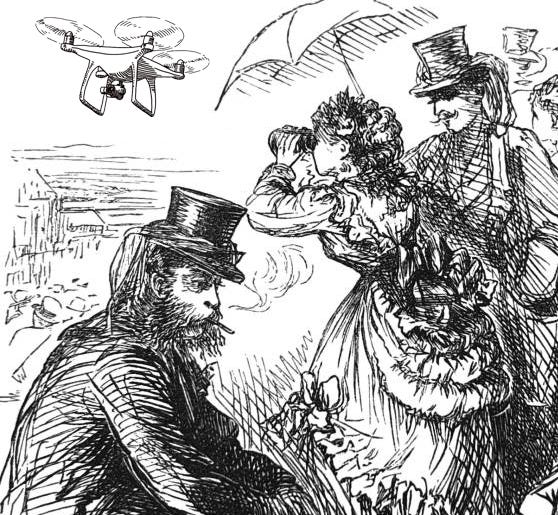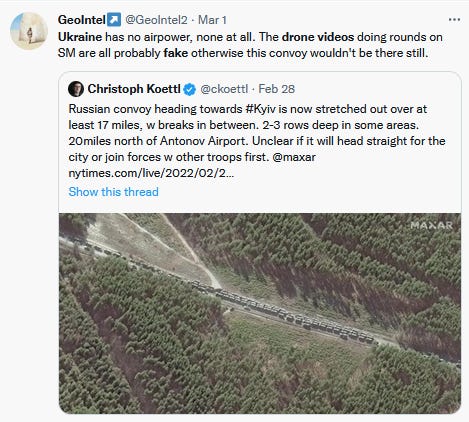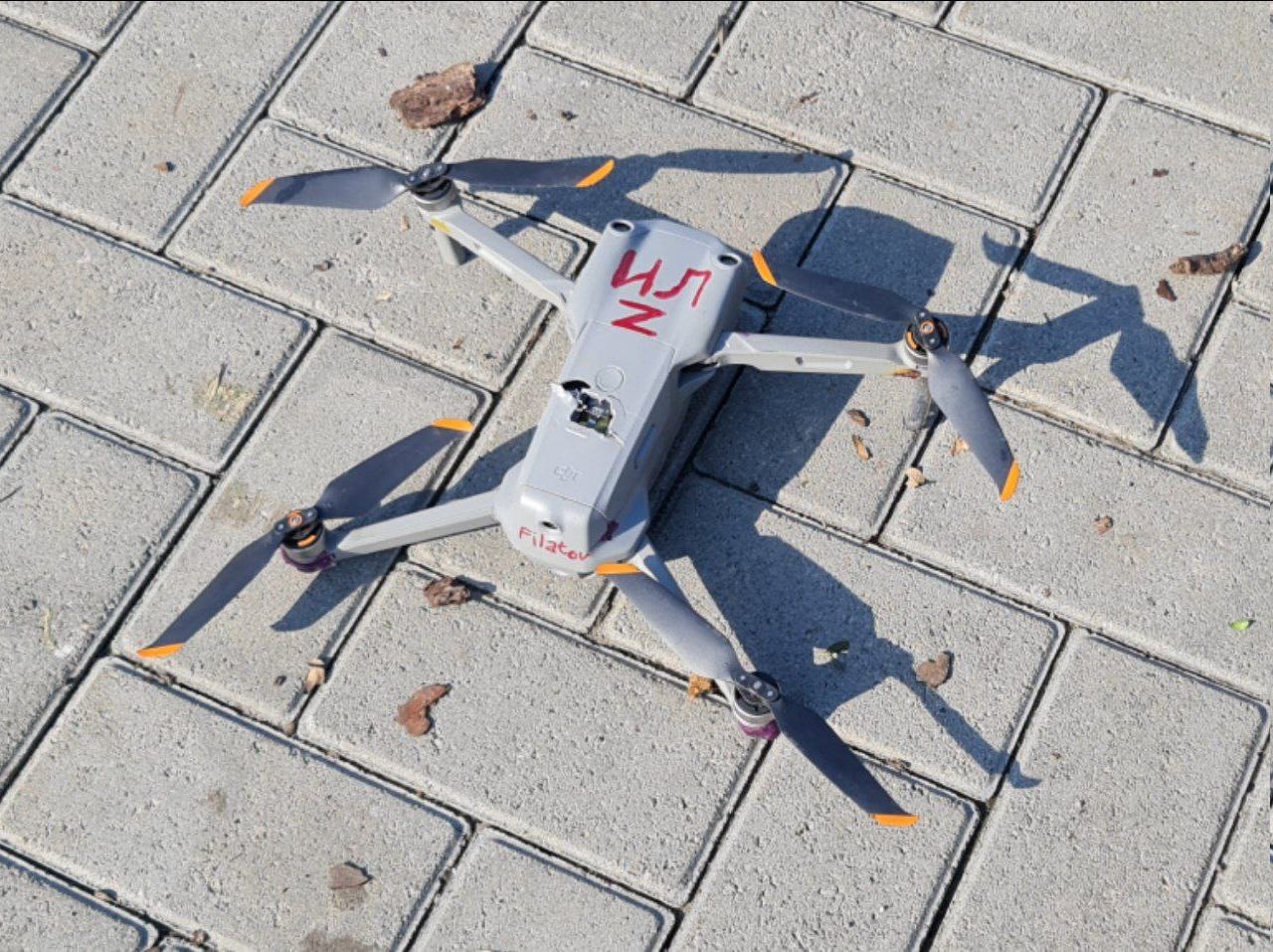Dronewatching in the Ukraine War. Part 1: An Incredible Aerial Spectacle
What have I learned from watching drones in the Ukraine war? In Part 1 of a series, I look at how drones represent an incredible visual spectacle.
I watch drones for a living.
It’s a pursuit that is, in some ways, rather similar to the work of an 1800s naturalist. As they did, drone watchers spend a lot of time observing little flying things at a distance. Like them, we also spend a lot of time bickering about taxonomy: the nature of things, the categories of things, where they fit into the broader ecological picture.
And I think if people like me were talking to to those long-dead naturalists today, they’d agree that the nightmarish war that Russia’s vicious 2022 invasion started has created a thriving and remarkably bio-diverse ecosystem of little flying robots. A Cambrian explosion of drones and things that people can do with drones, if you will.

Nor are these little flying robots static in their forms, in their behaviors. They are evolving at a terrifically fast rate, as Ukrainian drone pilots, hackers, and engineers- locked in existential conflict with a far-bigger power - throw every ounce of talent and ingenuity they have at making the drones they already have, and the tactics that they use them with, that much better. So too have the Russians been forced to furiously adapt their own methods of using small, cheap drones, and the drones themselves, to keep up with the pace that Ukraine has set.
Since Russia first launched its idiot invasion of Ukraine in early February of 2022, I’ve been maintaining an online database of how small, consumer drones are being used in the war. By “small, consumer” drones, I mean cheap drones, civilian drones, the kind of drones made by DJI and other mostly-Chinese manufacturers that people can buy online and at camera stores for a few thousands bucks in almost every country in the world.
These are the drones that have always interested me - far more than expensive and intentionally military-use aircraft - precisely because they are so accessible and so easy to use. For the first time in history, just about anybody with a pulse and functional thumbs can put an ultra-high-resolution camera into the sky.
I started the database because I wanted to answer a few fundamental questions: what does all this furious drone activity, this mayfly-like proliferation of cheap little camera robots mean? What have we learned so far? And how can we apply what we’ve learned about small drones in conflict from Ukraine to other wars, and other disasters?
In this series, I’ll take you through my own takeaways from how drones have been used by both Russia and Ukraine during this senseless, stupid conflict: the things I’ve seen as I observe, with metaphorical binoculars, a flock of little flying robots on a hellish modern battle field.
Let’s start, as seems appropriate, with fireworks. With spectacle.
PART ONE: THE DRONE VIEW AS SPECTACLE
A ultra-high-resolution view of a missile slamming into a helicopter on the wing, shot from a flying camera hovering close by at the same altitude as the unfolding violence. An aerial record of Russian bombings at the enormous Azovstal factory: soon after, lingering aerial footage of exhausted Ukrainian fighters leaving the scene into Russian captivity, carrying their wounded comrades on stretchers. A Russian tank firing upon a single unarmed person in Bucha who had dismounted from their bicycle, and, fatally, began to walk it slowly up to the next corner.
No war in human history has even been so profusely documented as the one in Ukraine in 2022 has been .No war has ever been so thoroughly observed from the sky. As I write this, in late 2022, it seems as if every other video posted on Telegram, or YouTube, or Twitter from the Ukraine War was shot with a drone. They have, in the space of just a few months, become a totally ubiquitous - and so common as to be almost unnoticeable - aspect of how we view modern warfare.
How the hell did we get here?
At the beginning of the war in Ukraine (just a few months ago, which feels like a millennium), some people would respond to those stunning drone videos of explosions and artillery strikes with incredulity. “That’s obviously Photoshopped,” they’d scoff, knowingly, on Twitter.

But the videos weren’t fakes, of course.
We now have many thousands of them (which I’m constantly struggling to even attempt to keep up with in my Ukraine drone database). They are real, nightmarishly real, and yet I can, to a certain extent, understand people’s skepticism about them. They appear to occupy a space of unreality simply because we’ve never seen anything like them before.
Ukraine’s remarkable command over small drones as a weapon of war didn’t come out of nowhere. In fact, Ukrainians were some of the first people in the world to see the potential of drone video and photos as a rhetorical tool, a way of winning an argument against a vastly bigger power.
The modern consumer drone revolution, as we know it today, arguably began in 2013 - and Ukrainian filmmakers and model aircraft hobbyists were there from the start. Ukrainian drone pilots used the 2013 and 2014 Euromaidan protests in Kyiv from the sky.
In 2014, months after the first Russian invasion in late February, a group of Ukrainians launched the now-globally famous Aerorozvidka, a volunteer group that customized inexpensive hobby drones both for intelligence gathering and for dropping explosives. In 2015, Ukrainian drone pilots shot and promoted 3D models of the destruction in Donetsk after the first Russian invasion, impressing journalists from around the globe.
As the shadowy border conflict between Ukraine and Russia ground on in the intervening years, Ukrainian fighters posted a steady drumbeat of remarkable drone videos on the Internet, from hobby FPV drones buzzing startled Russians in Donbas trenches, to harrowing videos of the damage wrought by ongoing fighting.
By the time of Russia’s 2022 invasion, Ukrainian drone pilots had become some of the most highly experienced drone users - and producers of drone combat video - in the world. They were able to hit the ground running. Ukraine’s drone pilots, hardened from years of experience, immediately began pumping out video on social media and to the media. The world began to watch the war not just from the perspective of a drone, but, specifically, from the perspective of drones flown by Ukrainians.
Russian fighters, meanwhile, had built no such experience in the years between 2014 and 2022. They had no particular incentive to do so, and they were largely using (or so we assumed, anyway) much more expensive, professional drones that lent themselves less readily to YouTube.
As it became apparent to Russia in early March 2022 that the Ukraine War would not, in fact, be the walk in the park that Putin had planned, they began to scramble furiously to catch up - both in military terms, and on the global battlefields of social media. They realized that the drone’s eye view was an important one, and that they would be foolish indeed to cede the aerial perspective entirely to Ukraine.
Slowly at first, and then more and more rapidly, Russian fighters began to post their own videos shot with small, consumer or DIY drones of their battles with Ukrainian fighters. They conferred with Russian drone experts to figure out how to hack consumer DJI drones so that they could not be easily identified with DJI’s proprietary Aeroscope technology.
As the spring and then the summer wore on, Russian-sympathizing Telegram channels featured regular posts from Russian fighters who expressed anger about the slow pace of small-drone uptake on the front. They complained about customs officials tripping them up. And just like the Ukrainians have been doing since 2014, they organized crowd-sourcing drives to secure both the drones (including DJI models now no longer sold officially in Russia) and the funding to buy them.

Russian pro-regime journalists and propagandists, too, swiftly became relatively adept and courageous small-drone pilots, learning how to tell stories using drones as the visual medium. These Russian media-makers - both from official outlets like Izvestia and smaller, Telegram-based outfits like WarGonzo - swiftly began to rely heavily on their own drone-collected footage, as they followed Russian forces on their bloody path through Ukraine. The Russian journalists even reported cases where their DJI Mavic drones took a bullet and lived to tell the tale.
They helped popularize the now pervasive idea, on both sides of the conflict, that the DJI Mavic was something like a modern Kalashnikov: a cheap, indispensable, and easily available tool for all seasons. And unlike the Kalashnikov, a DJI Mavic could be used to tell stories and to promote a particular point of view, collecting images that people around the world would instantly see.
As write this in November 2022, Russian fighters and their supporters have come close to parity with Ukraine when it comes to using small, inexpensive, consumer and DIY drones on the battlefield. Russia claims it’s developing its own small quadcopter that can compete with DJI (a claim that I’m highly skeptical of). Newly-mobilized Russian forces have been encouraged to bring their own quadcopters from home to the front-lines.
The sea of drone videos that have emerged from the 2022 Ukraine War have developed a particular, professional style. Fast, almost Tik-Tok like clips, often stitching together shots taken from drones in the air and people on the ground with action cameras. Diagrams and explanatory imagery superimposed over the drone footage, explaining what’s going on for the viewer - rather often in English, to ensure that international audiences can track what’s going on.
Then, there’s the music.
The drone video soundtracks fit into about three categories: cartoonish, silly clown music (to highlight how dumb your enemy is), thrilling electronic dance music (to demonstrate how cool this all is), or dark, dank techno or rock music (to demonstrate how badass you are).
The below video from Aerorozvidka is perfect illustration of the type - I’ve probably heard this particular honk-honk filled song a hundred times in drone videos coming out of this war by now.
Dronephobia.
— Aerorozvidka (@aerorozvidka) 10:02 AM ∙ Aug 15, 2022
Symptoms:
- the patient suddenly jumps up;
- a calm state turns into a panic attack;
- disorderly running in different directions;
- noise and buzzing in the ears.
From time to time he looks up, after which the symptoms only worsen.
#aerorozvidka
This style might be distinct, but it isn’t new. It inherits a tradition.
I can trace it back to 2013 and the very start of the modern consumer drone boom, when hordes of antediluvian YouTubers and Instagrammers started flooding social media with videos of drones flying over surfers and swooping (ironically) though the ghostly abandoned buildings of Chernobyl, cut to dank beats.
Most modern drones don’t capture any sound in the video they collect, because it would be pointless: the incessant whine of the propellers drowns out everything else. Thus, video editors are obliged to put some kind of music over the footage to compensate. Drone video is usually rather thrilling, high-octane, dramatic, and so the electronic dance tracks of the 2010s were a natural fit.
And thus, those sun-tanned millennial v-loggers with drones became the unknowing parents of a new and visceral genre of war photography.
Swiftly, as the Ukraine War escalated, small consumer drones became more than ways to collect imagery, and to communicate: they also became tough-guy status symbols in and of themselves.
I’ll talk about that in the next post in this series.
